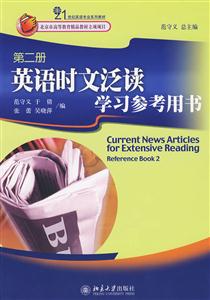-
>
西班牙语词根宝典
-
>
英语大书虫世界经典名译典藏书系:中国人的精神 (英汉对照)(精选权威版本)
-
>
许渊冲译唐诗三百首:汉文·英语
-
>
四级词汇词根+联想记忆法:乱序版
-
>
The secret garden
-
>
英国文学名篇选注
-
>
许渊冲译千家诗
英语时文泛读学习参考用书-第二册 版权信息
- ISBN:9787301159095
- 条形码:9787301159095 ; 978-7-301-15909-5
- 装帧:一般胶版纸
- 册数:暂无
- 重量:暂无
- 所属分类:>>
英语时文泛读学习参考用书-第二册 本书特色
外交学院英语教学专家编写;高等院校本科英语教育核心课程教材,北京市高等教育精品教材立项项目,北京市精品课程英语泛读教学用书;选材语言地道,内容新颖,题材广泛,贴近生活,时代气息浓郁,可读性强;根据不同主题设置不同单元,知识内容自成体系;练习设计合理、实用,紧扣课文内容,针对性强,形式灵活;难易程度恰当,有助于扩大国际视野,以适应日益增长的外交与对外文化交流的需要。
英语时文泛读学习参考用书-第二册 内容简介
针对学生的英语水平,《英语时文泛读》,可以在本科英语专业一、二年级或者二、三年级开设的阅读课程上使用,也可以供研究生或者高级英语培训项目的英语阅读课程使用。根据学生的实际水平和课程时间长短的要求,建议每两周使用一个单元,在课堂上仅处理text a和text b,text c作为课下阅读使用;教师也可以选取适合的单元和进度进行阅读课程的教学;也可以对文本的部分段落作“精读”处理,其他部分作“泛读”处理。
英语时文泛读学习参考用书-第二册 目录
unit one the impact of globalization
unit two controversies in 2 1 st-century america
unit three college and responsibility
unit four “new”generations
unit five paradoxes in reality
unit six people's place in society
unit seven human impact on nature
unit eight china's“growing pains”
第二部分 练习答案
unit one the impact of globalization
unit two controversies in 2 1 st-century america
unit three college and responsibility
unit four “new”generations
unit five paradoxes in reality
unit six people's place in society
unit seven human impact on nature
unit eight china's “growing pains”
第三部分 阅读技巧
i reading skills:skimming and scanning
ii miscellaneous reading skills
第四部分 英语知识
i list ofamerican words not widely used in the united kingdom
ii list of british words not widely used in the united states
英语时文泛读学习参考用书-第二册 节选
《英语时文泛读学习参考用书(第2册)》针对学生的英语水平,《英语时文泛读》,可以在本科英语专业一、二年级或者二、三年级开设的阅读课程上使用,也可以供研究生或者高级英语培训项目的英语阅读课程使用。根据学生的实际水平和课程时间长短的要求,建议每两周使用一个单元,在课堂上仅处理Text A和Text B,Text C作为课下阅读使用;教师也可以选取适合的单元和进度进行阅读课程的教学;也可以对文本的部分段落作“精读”处理,其他部分作“泛读”处理。
英语时文泛读学习参考用书-第二册 相关资料
插图:By now, a rocket will have set off on its 35 million mile trip to Mars and scientistsmust be waiting anxiously for the results. The rocket will be travelling for six monthsbefore it reaches the planet. It contains a number of scientific instrument, including atelevision camera. Any pictures that are taken will have to travel for three minutes beforethey reach the earth. If the pictures are successful, they may solve a number of problemsabout Mars and provide information about the markings on its surface which, nearly 100years ago, the astronomer, Schiaparelli, thought to be canals.It will be a long time before any landing on Mars can be attempted. This will onlybe possible when scientists have learnt a lot more about the atmosphere that surroundsthe planet. If a satellite can one day be put into orbit round Mars, scientists will be able tofind out a great deal. An interesting suggestion for measuring the atmosphere around Marshas been put forward. A rubber ball containing a radio transmitter could be dropped froma satellite so that it would fall towards the surface of the planet. The radio would signalthe rate at which the ball was slowed down and scientists would be able to calculate howdense the atmosphere is. It may even be possible to drop a capsule containing scientificinstruments on to the planet's surface. Only when a great deal more information has beenobtained, will it be possible to plan a manned trip to Mars.QUESTIONS1. How soon can scientists expect to receive any information concerning the nature of the surface of Mars?A. Within a year of the rocket's departure from earth.B. Not until a landing has been attempted.C. As soon as a radio transmitter has been dropped from a satellite.D. When certain scientific instruments have been landed on the planet.2. What might prevent scientists form trying to land men on Mars?A. The discovery that Schiaperelli
- >
自卑与超越
自卑与超越
¥16.7¥39.8 - >
罗庸西南联大授课录
罗庸西南联大授课录
¥16.6¥32.0 - >
伊索寓言-世界文学名著典藏-全译本
伊索寓言-世界文学名著典藏-全译本
¥9.3¥19.0 - >
上帝之肋:男人的真实旅程
上帝之肋:男人的真实旅程
¥19.3¥35.0 - >
中国历史的瞬间
中国历史的瞬间
¥16.7¥38.0 - >
月亮虎
月亮虎
¥14.4¥48.0 - >
我从未如此眷恋人间
我从未如此眷恋人间
¥17.5¥49.8 - >
经典常谈
经典常谈
¥19.5¥39.8
-
4.23文创礼盒A款--“作家言我精神状态”
¥42.3¥206 -
4.23文创礼盒B款--“作家言我精神状态”
¥42.3¥206 -
一句顶一万句 (印签版)
¥40.4¥68 -
百年书评史散论
¥14.9¥38 -
1980年代:小说六记
¥52.8¥69 -
中图网经典初版本封面-“老人与海”冰箱贴
¥20¥40



















